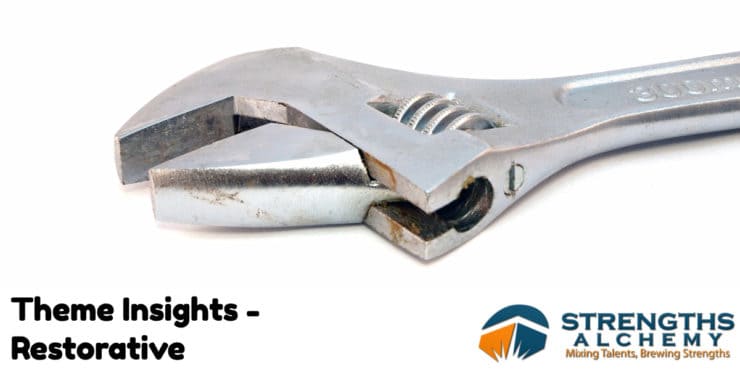
Gallup describes the Restorative Talent Theme as such:
You love to solve problems. Whereas some are dismayed when they encounter yet another breakdown, you can be energized by it. You enjoy the challenge of analyzing the symptoms, identifying what is wrong, and finding the solution. You may prefer practical problems or conceptual ones or personal ones. You may seek out specific kinds of problems that you have met many times before and that you are confident you can fix. Or you may feel the greatest push when faced with complex and unfamiliar problems. Your exact preferences are determined by your other themes and experiences. But what is certain is that you enjoy bringing things back to life. It is a wonderful feeling to identify the undermining factor(s), eradicate them, and restore something to its true glory. Intuitively, you know that without your intervention, this thing—this machine, this technique, this person, this company—might have ceased to function. You fixed it, resuscitated it, rekindled its vitality. Phrasing it the way you might, you saved it.
In one word – Fixer.
According to Gallup, the Restorative Talent Theme is the 9th most common talent out of 14 million people worldwide. If you have Restorative as a dominant theme, you’re comfortable with problems. You have insight into problems and a natural tendency to diagnose the root issue. Because you see problems as a normal part of life and not a burden, you are driven towards solutions and bring a solution-oriented mindset to everyday problems. You believe that things get done better or faster because a problem gets solved.
Restorative is the primary problem-solving theme, but it isn’t the only theme that enables people to solve problems; you may harness the themes Strategic, Connectedness, and Learner to solve problems too.
Restorative is calm in the face of problems. Command is calm in the face of crisis. Adaptability is calm in the face of change.
The Power and Edge of Restorative
If you are a Restorative, you bring power and edge by readily taking on projects that others believe cannot be solved. This gives a sense of reassurance and confidence to the people who are facing the problem.
Give a man a fish, and you feed him for a day. Teach a man how to fish, and you feed him for a lifetime. – Lao Tzu
You are in a great position to empower others to solve their own problems. Use your natural insights into problems to guide those around you :
- Understand what their barriers are.
- Ask them what they need to do to fix it, and acknowledge their responses.
- Walk through the steps with them. The self-awareness they get will help them decide how to do things better. For example, “Help me understand the impact of the decision that you’re about to make/ the solution that you’re going to apply”, or “If we fix this, what do we need to do so that we can ensure this doesn’t happen again?”
- Ask questions that slow people down and inject realization that they may be missing some steps.
Directing the Energy of Restorative Productively
If you are coaching or supervising someone with Restorative, help them to put words and value to their adeptness with problems.
- Help them find the best place to solve those problems. Look at their other themes, their experiences, and their values to figure out what kinds of problems are the best for them; people/process/high or low profile problems? Were they pervasive or one-off problems? In a world where they are doing what they do the best, what kind of problems will they be solving?
- Celebrate solved problems – those are Restorative’s biggest wins! It can be tempting to just move on, since solved problems may be enough recognition for them. But think about how to celebrate those problems solved, and about how to call upon the big and small problems they solve when reviewing their progress.
- Get them to think about what kind of a partner serves them best. Restorative holds dear the ability to cope with just about anything. Sometimes a lot of the value in someone with high Restorative is that they can cope with just about anything. That can go a little bit too deep. When they are able to assess what they bring to the table in a partnership, and who can be the best partner for them, they’ll be able to sustain their problem-solving energy much longer. Is it other Restoratives, friends, or someone with a complementary theme? Encourage Restoratives to reach out to their partners, so that they don’t get in too far over their head because they’re so good at coping.
Article informed by Gallup Theme Thursday.
